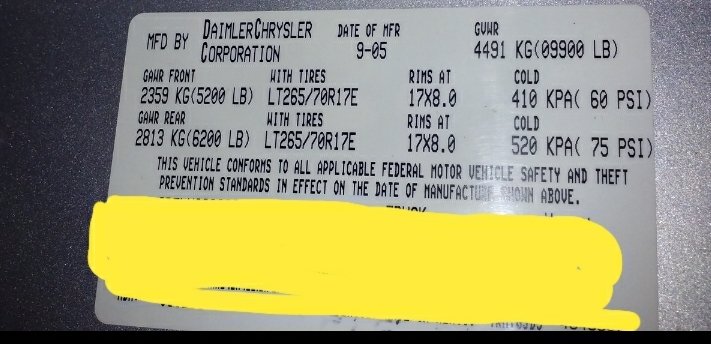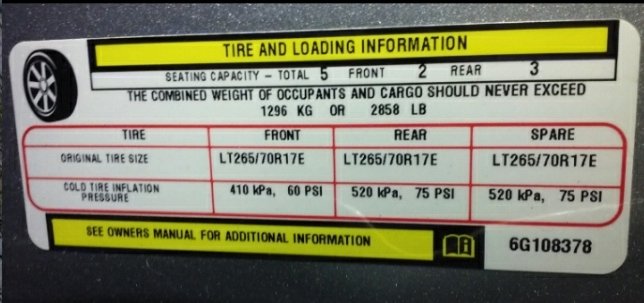Lou Schneider said:
The problem is the door sill placard doesn't tell how much weight the truck itself places on each axle, just the GAWRs. GAWR = Gross Axle Weight Rating, i.e. the most weight the axle can carry.
The only way to find out how much payload is available on each axle is to run the truck across a scale and get the unloaded axle weights. The truck should be configured as it will be on the road, with a 5th wheel platform and any passengers and cargo it will carry.
Once you have this information, you can subtract the truck weight from each axle's GAWR to find out how much additional weight each axle can carry.
The GVWR is most the entire truck can weigh when loaded, the problem is a 5th wheel hitch is directly above the truck's rear axle so all of the trailer's pin weight is carried there, not distributed between the front and rear axles. Carrying cargo or towing a conventional trailer using a weight distributing hitch distributes the weight to both of the truck axles. The rear axle's GAWR and the maximum pin weight it can carry will most likely be the limiting factor on how large of a 5th wheel you can tow, not the truck's overall GVWR.
I have had a several 5ers and have weight each one and I was well under my axle weights when I exceeded my GVWR. Here is my last weight of 35 foot 5er and you see my rear axle rating is 7,000 pounds and my CAT scale weight is 6320 and I'm within 180 pounds of my GVWR.... I would like to see a CAT scale ticket that exceeds the 7,000 lbs axle rates and not be way over the GVWR of the truck. On every CAT scale ticket I have seen the GVWR was exceed long before the axle ratings.
Truck Specs
Ford F350 Diesel SuperCab 143? Wheel Base 6.5 foot bed.
B&W Campion Hitch non slider
Web Spec 4080 Payload
Yellow Door Sticker 3744
GVWR 11,500
Rear Axle Ratings 7,000
Front Axle Ratings 5,200
GCWR 22,500
Tow Rating 15,900
Truck ONLY Weight Cat Scales
Front Axle Weight - 4740
Rear Axle Weight - 3480
Total Weight 8220
Cat Scale With 5er Hooked up
Steering Axle - 5000lbs
Drive Axle 6320
Trailer Axle 10,520
Gross Combine Weight 21,840
Bottom Line
Truck Weight (Truck Only) 8220
Truck Weight (Hitched) 11,320
Camper Weight 13,620
Pin Weight 3,100
Pin Weight Percentage 22.8%
2392 Factory Pin Weight 3100 scale weight increase of 708 pounds
12,226 Factory UVW 13,600 Cat Scale Weight increase of 1374 lbs
Over 50% of the 1374 pounds loaded went to pin weight
Just goes to show how much weight is loaded forward of the axle
Factory Scale weighs of 2392 pin and 12,226 UVW = 19.6 percent pin weight
Cat Scale Weights 13600 GVW and 3100 pin = 22.8 percent pin percentage or increase of 3.2 Percent over Dry percentage
I?m within 180 pounds of my GVWR of my trucks 11,500 GVWR. We were loaded for a week long trip and we are not full timers.


